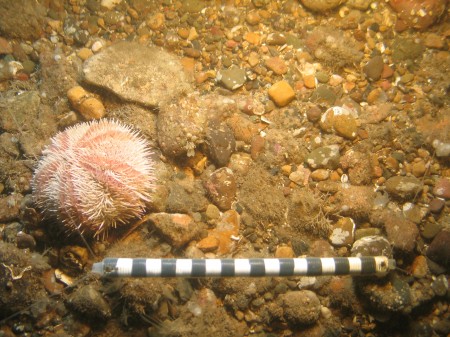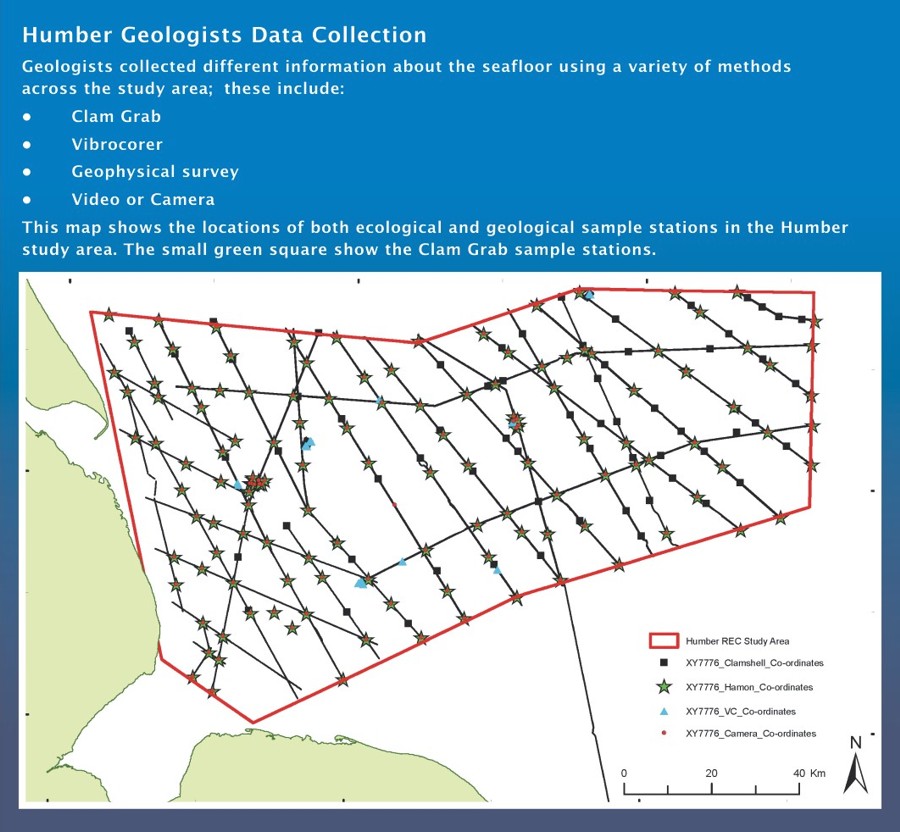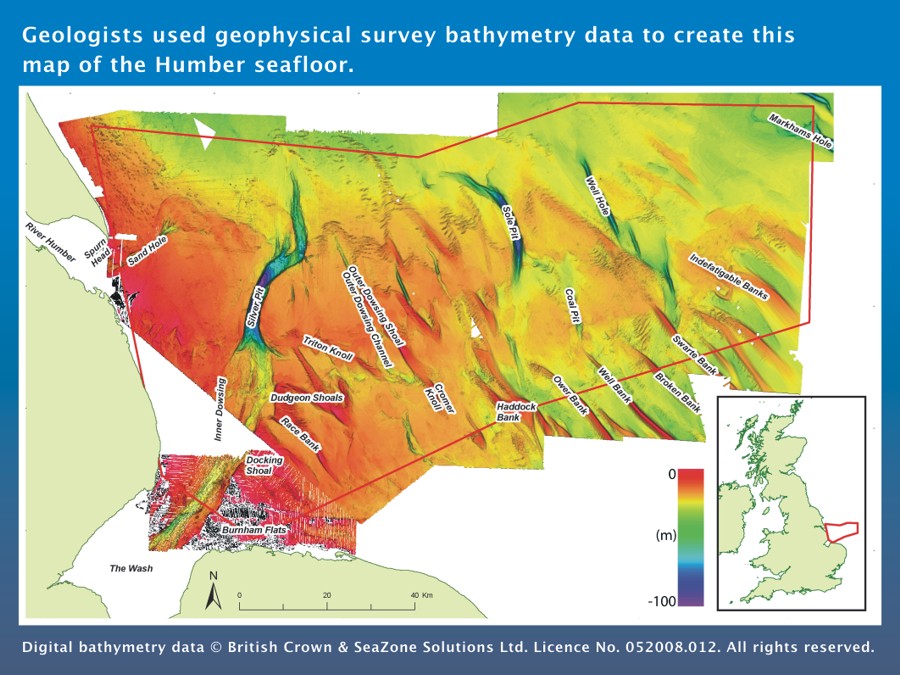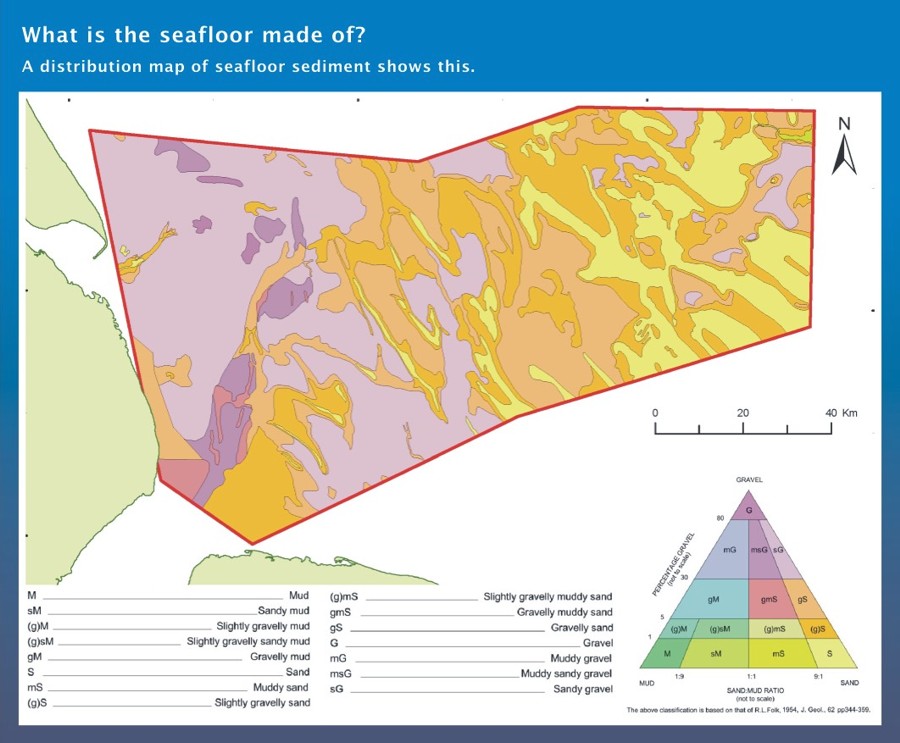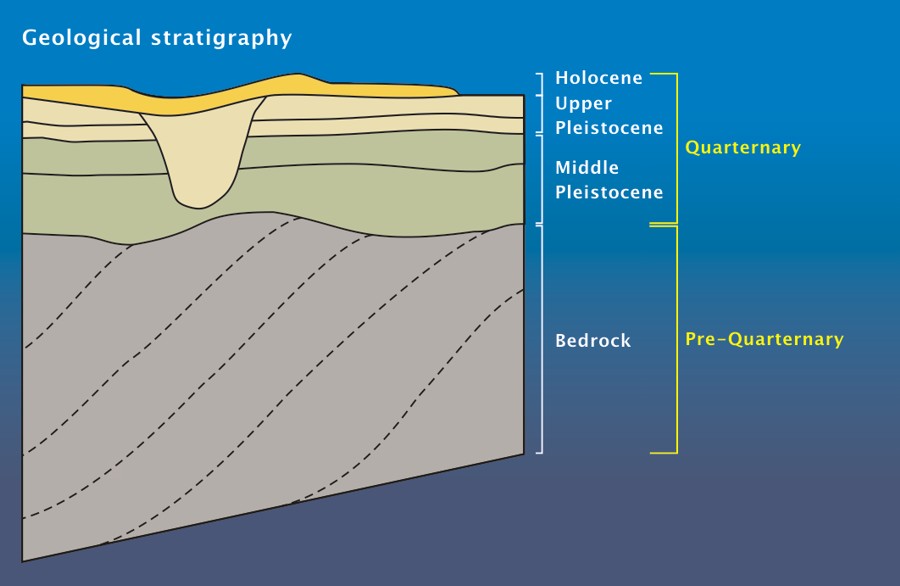Geologists studied the formation and structure of the Humber seafloor – how it was shaped, what the sediment cover on the seafloor is made of and what rock formations lie beneath the seafloor sediments. This information is vital to the RECs, creating maps of the seafloor for other scientists to use.
Geologists use two main methods to study the seafloor and underlying sediments and rocks. Geophysical survey techniques use sound waves to map the seafloor morphology, the thickness of seafloor sediments and the rocks underlying these sediments. They also take samples of the seafloor sediments and underlying rocks using grabs and vibrocorer to ‘ground truth’ the geophysical surveys.
The geological maps form an essential foundation for the Humber REC archaeological and ecological research and interpretations. They help identify where humans might have lived when sea levels were lower exposing the seafloor, and on what type of sediment certain groups of animals prefer to live today.
Humber REC Geology Results
This section provides a summary of the Humber REC results for the geological research.
Click on the links below to find out about each topic, or scroll down to read the entire text.
- What does the seafloor look like?
- What is the seafloor made of?
- Geological timechart
- Underneath the seafloor
- How is the seafloor made?
You can find our more about the scientific research techniques mentioned in the sections below by visiting our “How we study the seafloor” webpages.
You can find out more about the role of geology in other areas of the REC research by visiting the Humber’s Ecology, Archaeology and Sustainability webpages.
What does the seafloor look like?
An important task for the Humber geologists is to understand the morphology of the seafloor. This involved creating a 3-Dimensional map of what the seafloor looks like.
Geologists added the new Humber geophysical survey data of the variations in the depth of the sea to previous data sets, collected before the REC, to create these 3-D maps. These are the first maps of this kind for the Humber REC study area. They effectively stripped away the water so that the geologists could visualise the seafloor as if it were part of the mainland, complete with undersea valleys and hills.
The new Humber REC maps revealed that water depths are mainly shallow, less than 50 metres deep. It showed that the seafloor is planar, which means it is flat and slopes gently to the east. However, it also highlighted major features on the seafloor, for example deep-water channels. These curved or straight channels cut through the seafloor and are called ‘pits’ or ‘deeps’.
There has been some debate about how these deeps were formed. It is probable that they formed over 10,000 years ago during the last Ice Age, carved into the seafloor by fast flowing rivers underneath the ice sheet.
 What is the seafloor made of?
What is the seafloor made of?
The seafloor is formed by a layer of loose or ‘unconsolidated’ sediments. Geologists studied samples of the Humber seafloor sediments to understand what they are made of.
Out on the boat, geologists took seafloor sediment samples across the Humber REC study area, using a range of different size grabs. In addition, they used geophysical survey techniques to measure the thickness of these modern sediments.
Geologists examined the particle size and properties of all the seafloor sediment samples from the different locations. They classify the size using a system called Folk Classification.
The mapping of the seafloor properties shows that different areas are characterised by different types of seafloor sediment. For example, the seafloor in the east of the Humber is mainly sand, while in the west it is gravel.
In the Humber the seafloor sediments are often very mobile, meaning that they are constantly being moved or ‘re-worked’ by the tides and currents. Sand is the most mobile sediment and the sea currents create features with the sand on the seafloor, for example sandbanks and sandwaves.
These deposits are Holocene sediments, laid down during the last 11,700 years. Sometimes this layer is very thin, called a ‘veneer’ overlying older deposits. You can find out about these deposits in the section below. On occasions these older deposits can be seen at the seafloor surface; this is called ‘outcropping’.
Geological timechart
Underneath the seafloor
Underneath the unconsolidated seafloor sediments there are older geological deposits that the Humber geologists also need to understand.
To do this geologists use special equipment called a vibrocorer to push up to a maximum of six metres down into the seafloor and collect samples. They also use sound waves to image deep into the seabed to see even older and deeper deposits.
Quaternary deposits
Underneath 90% of the loose seafloor sediments in the Humber REC study area you will find a seafloor deposit made of hard clay with boulders and gravel called the Bolders Bank Formation. Although it is hard, it is not cemented. It is up 25 m thick. In places where the seafloor sediments above are very thin, this hard clay lies very close to the seafloor. These deposits formed over the Quaternary period in geological history, which spans from around 2.6 million years ago until the end of the last Ice Age 10,000 years ago.
Bedrock
Beneath the Quaternary deposits lies true rock, this is called ‘bedrock’. It is millions of years old. It is the first cemented layer of the earth’s surface. It can be made of a variety of material, for example, sandstone or chalk. In the Humber REC study area, the bedrock in the east is made of mudstone and sandstone. In the west, the bedrock is made of Cretaceous Chalk. Although the bedrock is present everywhere in the Humber REC area, very little is actually exposed at the surface of the seafloor. This is because the seafloor sediments and the hard clay of the Bolders Bank Formation cover the bedrock. Only in the deep channels, like the Silver Pit, is bedrock exposed.
How is the seafloor made?
Geologists need to understand the geological processes that created the Humber seafloor, over a period of time which spans millions of years.
Cretaceous Period
The oldest bedrock was formed 65 million years ago, during the Cretaceous Period on the geological timescale, from the decayed and compacted skeletons of marine life. Because these rocks are so rarely exposed at the seafloor, they are not of primary interest to the Humber REC geologists.
Quaternary Deposits
During the last Ice Age, the Humber REC area lay at the southern end of a massive ice sheet. The hard clay deposit called the Bolders Bank Formation, lying underneath the seafloor sediments, was formed around this time.
The clay was laid down beneath the ice sheet that formed over England and extended into the North Sea. The Bolders Bank Formation is hard because it was formed beneath the weight of the thick ice, compacting it.
During this time, glaciations repeatedly took place. Glaciers eroded the surface of the planet, creating and moving sediment, and led to the formation of many seafloor features like deep-channels. This period therefore had an important role in the formation of the seafloor.
Since the last Ice Age: seafloor sediments
 When there were glaciers across Britain, sea levels were low, so at this time the Humber REC area was dry land. When the climate warmed up, about 10,000 years ago, the ice melted and retreated, leaving the Bolders Bank Formation.
When there were glaciers across Britain, sea levels were low, so at this time the Humber REC area was dry land. When the climate warmed up, about 10,000 years ago, the ice melted and retreated, leaving the Bolders Bank Formation.
For a few thousand years the area was dry land, vegetation grew and people probably lived there by rivers and lakes. As the climate continued to warm, sea level rose and by approximately 8,000 BP the area was flooded by the sea.
The sea moved sediments creating features such as sandbanks that can be seen today on the seafloor. In the west of the Humber REC study area strong currents removed the finer sediments, leaving the gravel seafloor present there today.
Today, the continued activity of sea currents and tides means that the sediment distribution and seafloor morphology will change in the future. Any change will affect the habitats of the sea animals, whose presence and distribution is dependent on the type of seafloor sediment.











